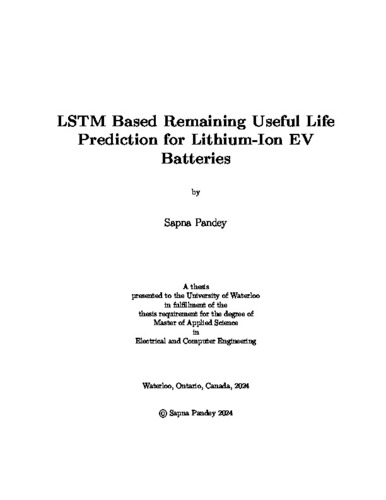| dc.description.abstract | Lithium-ion batteries are commonly used in electric vehicles (EVs) because of their high energy density, ability to provide good efficiency, and being lightweight. Predicting the Remaining Useful Life (RUL) is critical in lithium-ion batteries as it helps optimize efficiency and timely replacement of these batteries. To optimize the battery performance, it is critical to predict RUL and lithium-ion batteries' End of Life (EOL). There are several approaches for RUL estimation in lithium-ion batteries, such as model-based, data-driven, and hybrid approaches. Out of all the approaches, data-driven approaches, such as, Recurrent Neural Networks (RNN), Support Vector Machines (SVM), and Long Short-Term Memory (LSTM) have gained popularity due to their less complexity and adaptability. In this study, we have investigated the LSTM networks for RUL estimation in lithium-ion batteries.\\
The first part of the study shows the effect of different parameter changes, such as hidden nodes and window size, in LSTM networks. The investigation reveals that increasing the number of hidden nodes before encountering overfitting improves prediction accuracy and lowers the Root Mean Square Error (RMSE) from 0.2 to 0.03. The experiments to find the ideal window size for the LSTM model used in this study illustrate that the model shows improvement with a higher window size up to a maximum of 14. Moreover, in the second part of this study, we propose an incremental LSTM model for time series forecasting that incorporates the newly available data at each time step and updates itself to make better predictions of future capacity values. The proposed incremental LSTM model improves the RMSE by 17.6\% compared to the baseline LSTM model. For further analysis of real-time RUL estimation where there is limited data, and the user wants to predict the RUL at any moment, another LSTM model that considers these assumptions is proposed. The models are trained and tested with the help of two publicly available datasets: The lithium-ion battery aging dataset by NASA Ames Prognostics Center of Excellence (PCoE) and the battery dataset by the Center for Advanced Life Cycle Engineering (CALCE). This research proposes LSTM models that are useful for accurately estimating RUL in lithium-ion batteries, which is critical for Electric Vehicles (EVs). | en |

